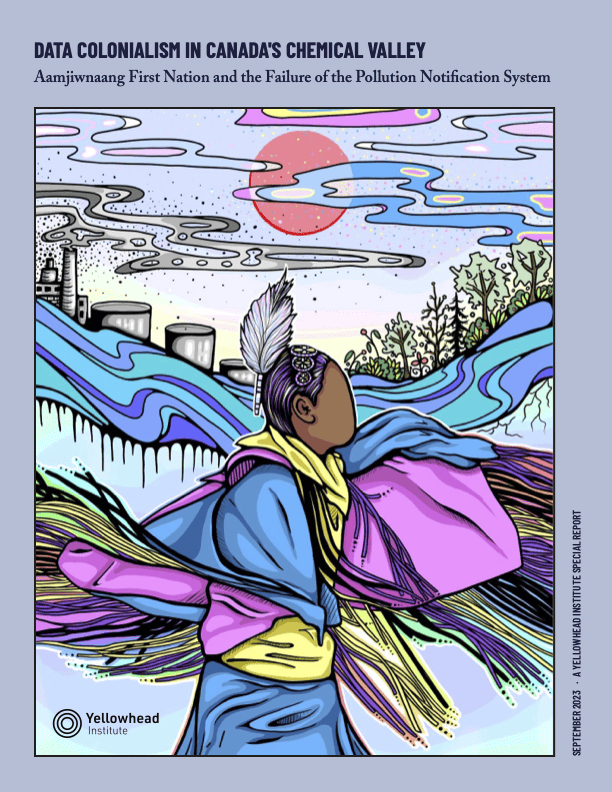- About
- Research
-
-
- Special Reports & Features
- Pretendians and Publications: The Problem and Solutions to Redface Research
- Pinasunniq: Reflections on a Northern Indigenous Economy
- From Risk to Resilience: Indigenous Alternatives to Climate Risk Assessment in Canada
- Twenty-Five Years of Gladue: Indigenous ‘Over-Incarceration’ & the Failure of the Criminal Justice System on the Grand River
- Calls to Action Accountability: A 2023 Status Update on Reconciliation
- Data Colonialism in Canada’s Chemical Valley
- Bad Forecast: The Illusion of Indigenous Inclusion and Representation in Climate Adaptation Plans in Canada
- Indigenous Food Sovereignty in Ontario: A Study of Exclusion at the Ministry of Agriculture, Food & Rural Affairs
- Indigenous Land-Based Education in Theory & Practice
- Between Membership & Belonging: Life Under Section 10 of the Indian Act
- Redwashing Extraction: Indigenous Relations at Canada’s Big Five Banks
- Treaty Interpretation in the Age of Restoule
- A Culture of Exploitation: “Reconciliation” and the Institutions of Canadian Art
- Bill C-92: An Act respecting First Nations, Inuit, and Métis Children, Youth and Families
- COVID-19, the Numbered Treaties & the Politics of Life
- The Rise of the First Nations Land Management Regime: A Critical Analysis
- The UN Declaration on the Rights of Indigenous Peoples in Canada: Lessons from B.C.
- View all reports.
- Special Reports & Features
-
-
- Yellowhead School
- The Treaty Map
- LIBRARY
- Submissions
- Donate
SPECIAL REPORT
Data Colonialism in Canada's Chemical Valley: Aamjiwnaang First Nation and the Failure of the Pollution Notification System
This report is about the relationship between the petrochemical industry in Ontario’s Chemical Valley and Aamjiwnaang First Nation. Central to this relationship is pollution: the spills, flares, air releases and how those events are communicated to the community.
Communication about pollutants is regulated by provincial and federal governments, which actually provide limited oversight, allowing Shell, ExxonMobil, and other petrochemical polluters to form their own industry associations that determine what information is provided to the community and when.
A notification system to alert those in the Valley to any spills, releases, or accidents has been designed by the industry associations to obscure the environmental violence they are responsible for. Since 2004, community members affected by this violence — those from Aamjiwnaang First Nation — have collected data on the notifications that reveals how companies purposefully try to hide their harmful activities and bad faith practices.
Aamjiwnaang First Nation is most directly affected by the infrastructure of colonial entitlement that allows government and industry to pollute in Chemical Valley, but data misinformation is a global project headed by some of the biggest multinational oil companies in the world. While better data will not end pollution, fossil fuel capitalism, or colonialism, environmental evidence and community expertise can be used to imagine better ways to collect, manage, and govern pollution data.
This Special Report describes the permission-to-pollute system in Chemical Valley, explains how industry manipulates data, and looks to community members of Aamjiwnaang First Nation for alternatives to data colonialism.
This report is a collaboration between Yellowhead Institute and the Technoscience Research Unit at the University of Toronto.
KEY QUESTIONS
How can Indigenous environmental data justice practices help protect communities from the bad faith misinformation practices of the petrochemical industry?
Why do the provincial and federal governments allow multinational corporations to decide how to share pollution information with First Nations?
RELATED RESOURCES
Education Resource
Pollution Notification Map
The Technoscience Research Unit at the University of Toronto created an interactive map and graphics that offer insight into the density of pollution events in Aamjiwnaang. The map visualizes notifications from 2013 until the 2023 publication of this report. The data can be filtered by incident type, season, and company responsible.
FACTSHEET
FAQs about the Pollution Notification Map and Data
This factsheet offers important contextual and explanatory information about notifications, pollution incidents, the map data.
FACtSHEEt
Recommendations
This factsheet outlines three categories of recommendations: Harm-Reducing Recommendations for Industry; Recommendations for the Federal and Provincial Governments, and Recommendations for the Bluewater Association for Safety, Environment, and Sustainability (BASES)
“When you stand anywhere in Chemical Valley, the intensity of pollution and industrial activities is immediately evident. You can see the plumes of smoke in the sky, the bright flares on top of the stacks, the pipelines crisscrossing the land, the railways cutting across the roads, and the hundreds of rusty unlabeled tanks. Sometimes, you can smell something in the air, feel a sensation on the skin, experience disrupted breathing, or have a mysterious headache interrupt your day..."
- vanessa Gray, Beze Gray, Fernanda Yanchapaxi, Dr. Kristen Bos, Dr. M. Murphy
AUTHOR

Vanessa Gray
Anishinaabe kwe, Aamjiwnaang First Nation
AUTHOR

Beze Gray
Anishinaabe, Aamjiwnaang First Nation
AUTHOR

M. Fernanda Yanchapaxi
Kichwa / Mestiza
AUTHOR

Dr. Kristen Bos
Métis
AUTHOR

Dr. M. Murphy
Red River Métis
ARTIST

Mo Thunder Bedard
Haudenosaunee / Anishinaabe, Aamjiwnaang First Nation



